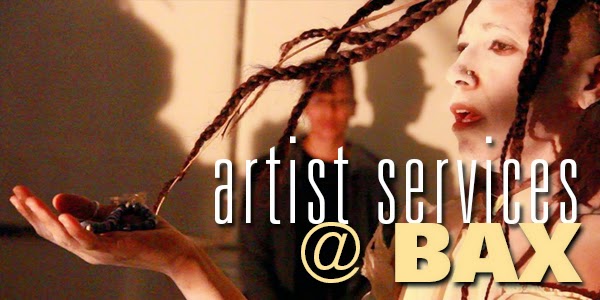THIS IS IT!
launched on March 29, 2007,
has just reached its 5,000th post!
Thank you so much for your support along the way.
Now, back to our regularly-scheduled review!
*****
 |
Oh. One more thing to celebrate...
We’ve scored a performance: a where-we-are but in your shoes. There are written prompts that overlap–a set of tasks that form a fairy tale weee invite you to complete.
We’ll play with race, lust, consent, underpaid labor and childhood shit; the cat and the meow. You’ve a choice: consent to be on stage or around it, as you will. We will take care of you.Not to be overly paranoid, but "we will take care of you" is a promise that can be read different ways, and I ended up relieved that I did not volunteer to be one of ten participants. Sure, I would have gladly held the orange tabby (see photo above) but last night, the second of the two-night run, there was no cat in sight and no meow to be heard.
Instead, there was an orchestral structure involving a score with instructions set up on a semicircle of music stands, precision timing regulated by digital clocks set up around the space. Participants had to read and then leave their timed instructions on the stands and enter the performance space just at the right moment to not strand one or another of their fellow players working off their own set of directions and schedules.
In one of a few efforts to ease any pre-performance jitters, though, Shalom told his willing participants, "There's absolutely nothing you can do wrong tonight. Whatever you do is the right thing to do."
Well, that's not exactly the case. In one instance, action had to be stopped and clocks reset for another go with a guy, stretched across a broken-legged sofa, saying "What if nothing is too serious to be joked about?" And there remained the possibility that someone from the audience-audience (unwilling non-participants) might stop the proceedings and the clock (by calling "Hold" into a dangling mic) to critique what had gone before.
And yes, that happened, although only once, the unwilling being particularly unwilling. But when it happened, it was a doozy.
One of the players, to the shock and amusement of the audience, had just finished pelting the wall and windows with half a dozen eggs. Smith showed up with a bucket of water and sponges, but one woman wasn't having it. She got up and took the mic.
"I want to see the white man clean up," she said, indicating Shalom and excavating what could have been buried deep in the minds of others. I chuckled and snapped because--you GO, girl!--that was top of mind for me. This directive from the audience-audience required a momentary negotiation between Smith and Shalom, but they managed it.
Now, mind you, that was a white woman. Most of the audience, unsurprisingly, was white. Most, I'm guessing, were artist types, performers even--which is why the willing participants seemed to look like they could well handle both the surreal theatrical activities of Dream State of Affairs and its controlled, highly-choreographed unfolding.
But one player, a white woman, seemed to balk at her next set of directions. She muttered something about not being sure she could do this before approaching one watcher and beckoning for him to come into the performance area. As she came up to me, I motioned towards my notebook, and she got the message.
She moved on, but it was a while before I figured out what was up. She had been instructed to pick out the Black people in the room. All five of us.
Without me, then, her meager haul was four. Once arranged in front of everyone, the Black people found out their fate. Again apologizing under her breath, she ordered them to turn around and stand with their arms against the wall and legs spread while the rest of the players, all of them white, whimpered in guilt. In short order, I swear to you, Smith turned all of this into the Hokey Pokey.
What if nothing is too serious to be joked about, indeed? The places your childhood memories take you? The rough debris of racial history and all the "crazy shit"--to quote Shalom's bio--that happens now? The sensuality and sexuality that only you can define? The struggle to survival and make your work in a tough market?
[Closed] For information on future events at The Invisible Dog, click here.















